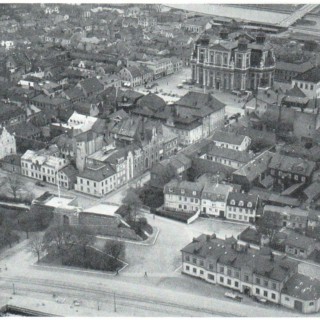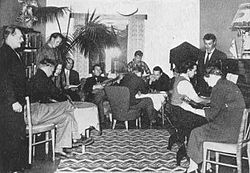
History
Sjömanshemmet was founded in 1909 at the initiative of the MP and navigation school administrator, Captain Alex Thore.
The purpose of the association’s formation was to offer seamen who came to Kalmar an alternative to the city’s taverns. Famous taverns were in the vicinity of ports in Southern Vallgatan, Kaggensgatan, Ölandsgatan and Östra Sjögatan.
In addition to the permitted taverns there were also numerous speakeasies often involving prostitution. The risk was great that newly arrived sailors ended up at one of these establishments immediately after going ashore.
There was simply a need for a counterweight, a home for sober sailors. From the association’s statutes of 1909, therefore, it can be read:
The association Kalmar Sjömanshem has the task to, in a way grounded in Christian spiritual and carnal values, seek to promote the wellbeing of seafarers who visit Kalmar.
The association succeeded after great difficulty to rent two rooms and a kitchen on S. Vallgatan 17.
It organized a reading and writing room, plus a lounge with newspapers for sailors. It also organized a coffee and tea service. On Sundays a mass was held and every Wednesday there were meetings with song, music and dance.
Here shelter for sailors was also offered to those who definitely lacked any means and were not welcome anywhere else. It is clear from the board protocol that some shelters in town had rejected some sailors because they were not clean enough.
During the first decade there were about 3000 visits per year. The need was in other words very large.
It is easy to understand the value of a home for the many young and older sailors who – contrary to the usual image of sailors in port – were married, settled, faithful and decent people.
Before the association came to its current premises, the so-called Nisbethska property on Ölandsgatan 45, it had been difficult to obtain in a fixed venue. The association moved around. From Södra Vallgatan 17 to Storgatan 27 – where KappAhl is now – to Södra Långgatan 73, the old navigation school.
In 1938 the association succeeded in buying the Nisbethska house for 45 000 kr and could move in after having paid a deposit of 7000 SEK. Nisbethska house has its own history. The yellow wooden house is to have been built in the 1700s. It was damaged in a fire in 1800 and rebuilt by a doctor named Boaz Johansson. The house was then purchased by Johan Olof Raab in 1829, who in 1837, transferred the property to Adam Christian Raab, who in turn sold it to the customs district manager Per Fredrik Nisbeth – hence the name.
His daughter, Fredegunda Nisbeth, started in 1865 a girls’ school in the property that functioned until 1875, when she died, at which point the school was moved and continued to operate at another location, run by her sister. A third sister, Alma, was involved in the foundation of K.F.U.K. and Kalmar Sjömanshem. After her death the Kalmar Sjömanshem association was able to buy the house.
Better location for its premises was not imaginable. From here there was a full view on the boats in the harbor. The home was easy to find. Here sailors were able to wash themselves clean, play pool, read and write letters in the library.
Gradually the sailors’ conditions on board the vessels improved. Shipping was rationalized. The numbers of sailors were fewer; they spent a shorter time if any time at all in ports, and the demand for home’s services decreased. In 1985 the house was renovated and turned it into what it is today.
Today, the foundation Kalmar Sjömanshem/Sjöfartsklubb runs a residence for students at the Kalmar Maritime Academy. The foundation manages and operates 13 student rooms and 5 apartments. The premises serve primarily as student accommodation but is also a natural gathering place for students of the Maritime Academy.
Most students visiting Kalmar Sjömanshem several times during their studies. And – even though times have changed – the purpose is the same as it was in 1909, namely to meet colleagues and exchange knowledge and learning experiences.

